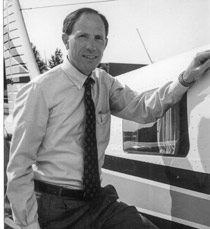 Staying on the centerline is important for both pilots and organizations. On this seventy-fifth anniversary of AOPA’s founding, the organization’s objectives remain the same. Others will address advocacy and fun while my focus will be on safety.
Staying on the centerline is important for both pilots and organizations. On this seventy-fifth anniversary of AOPA’s founding, the organization’s objectives remain the same. Others will address advocacy and fun while my focus will be on safety.
In response to an increasing accident rate that plagued a growing industry in 1950, the AOPA Foundation came to be. The United States was riding a post-World War II high and everything seemed possible. The greatest generation had returned from war and the mindset that was so successful in combat actually proved to be detrimental sometimes in civilian aviation. Mission mentality that is essential in war can be extremely dangerous in pushing civilian pilots to take risks that are completely unjustified by the reward—getting to the destination on schedule, for example.
The AOPA Foundation evolved into the AOPA Air Safety Foundation in 1968. That became the Air Safety Institute in 2010, a part of the AOPA Foundation formed in 2007. Corporate reorganizations are sometimes confusing, but the objective of helping pilots fly more safely hasn’t changed in 64 years. The AOPA Foundation’s mission has broadened, but the goal remains on the centerline that was set so many years ago.
The safety record is much better than in the 1950s and ’60s. Despite periodic handwringing that our safety culture is not up to airline standards—and it isn’t—it has improved appreciably in the past half century. The aircraft technology is better. We’re still saddled with some archaic designs (and certification restraints) in areas such as engines and basic airframe design/construction methods. But there have been huge improvements in instrumentation, warning systems, redundancy, airbags, collision and terrain advisories, weather forecasting, weather in the cockpit, and navigational ability.
Many pilots, exposed to societal cultural shifts, have a much improved safety mindset compared to earlier aviators. Expanded safety emphasis is seen everywhere: automobiles, toys, helmets for all kinds of sports, much magnified electrical and fire codes, food safety standards, et cetera. Litigation encourages companies to warn and design safely, which both encourages and stifles innovation. After accidents, regulations have closed real or perceived loopholes. Ultra-detailed rules often create complexity to resolve bureaucratic and legal issues rather than solve operational ones. I’m not convinced we’ve reached a good balance on either.
Invariably, the nature of some humans, outside of the heavily prescriptive and restrictive oversight in the airline and corporate world, is to experiment and push any limit that lets them get one more shot at the cookie jar. However, the steady drip of safety education from industry magazines, publications, DVDs, and websites cannot help but influence those horses that will drink the water that’s put in front of them. The Air Safety Institute took an early lead in this area and has been offering free live seminars nationally for more than 30 years. It conducted weekend ground schools and flight training clinics in the past. Communications technology has helped to disseminate high-quality programs faster and more cost effectively than ever. Last year ASI had more than 30 online courses, averaging in excess of 25,000 completions every single month. There were more than 1.3 million contacts with pilots—and yet the same types of mishaps occur. System failure or individual? I lean toward individual, but not in every case.
A good CFI can imprint the right safety culture and the odds improve that the student will absorb much of that. ASI’s course material to supplement instructor guidance and self-study is the best it’s ever been, and grows every year. The live Flight Instructor Refresher Clinic started in the early 1970s and, modestly, remains the best and the industry’s largest. Newly revamped, the online version delivers better content than ever. A digital newsletter is free to all registered CFIs, so there is no reason not to stay current, informed, and engaged.
 So much for self-congratulation, but can we drive the current accident rate lower? Probably, but not as quickly as we all would like. Rip Van Winkle types and the occasional bonehead steadfastly refuse to learn or teach differently. Sadly, aviation is no different than other human enterprises. We agonize over how to reach the unreachable. The challenge over the past 75 years has been to identify fools by some mark on the forehead and warn everyone to stay away. It hasn’t happened yet. Maybe in the next 75 years biomarkers will address that. In the meantime, all the old saws about the pilot being the first one to the scene of the accident and only one fatality to a customer still hold true. Flying can be easier and safer than it’s ever been, but you have to choose that path—it has always been so.
So much for self-congratulation, but can we drive the current accident rate lower? Probably, but not as quickly as we all would like. Rip Van Winkle types and the occasional bonehead steadfastly refuse to learn or teach differently. Sadly, aviation is no different than other human enterprises. We agonize over how to reach the unreachable. The challenge over the past 75 years has been to identify fools by some mark on the forehead and warn everyone to stay away. It hasn’t happened yet. Maybe in the next 75 years biomarkers will address that. In the meantime, all the old saws about the pilot being the first one to the scene of the accident and only one fatality to a customer still hold true. Flying can be easier and safer than it’s ever been, but you have to choose that path—it has always been so.
Bruce Landsberg joined AOPA in 1992 and was named president of the AOPA Foundation in 2010.



